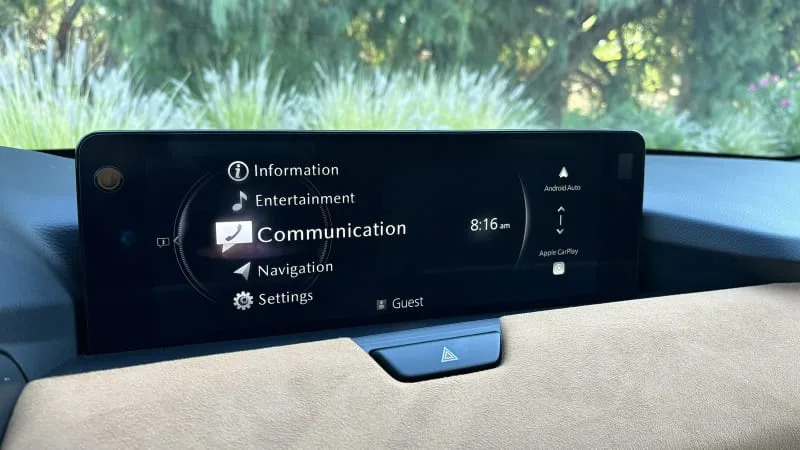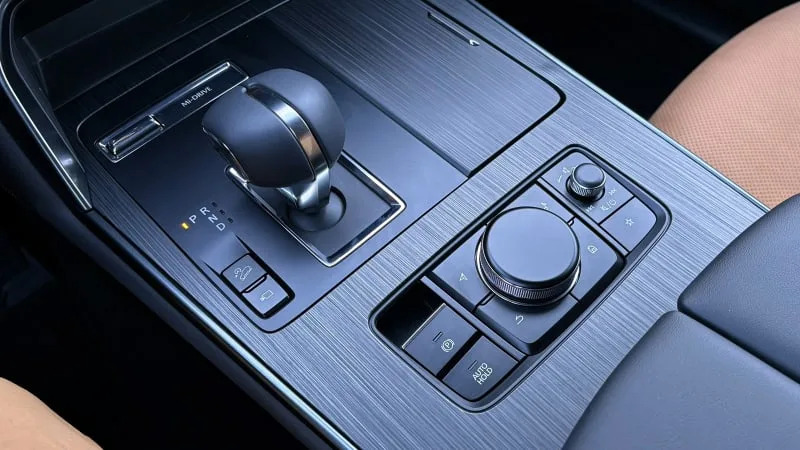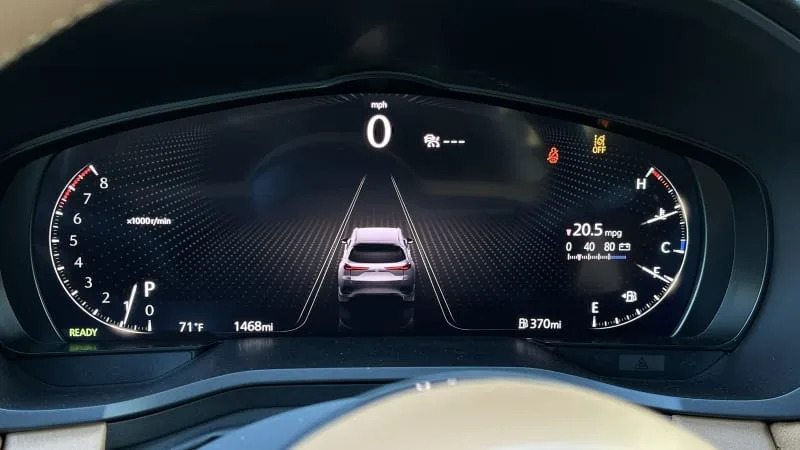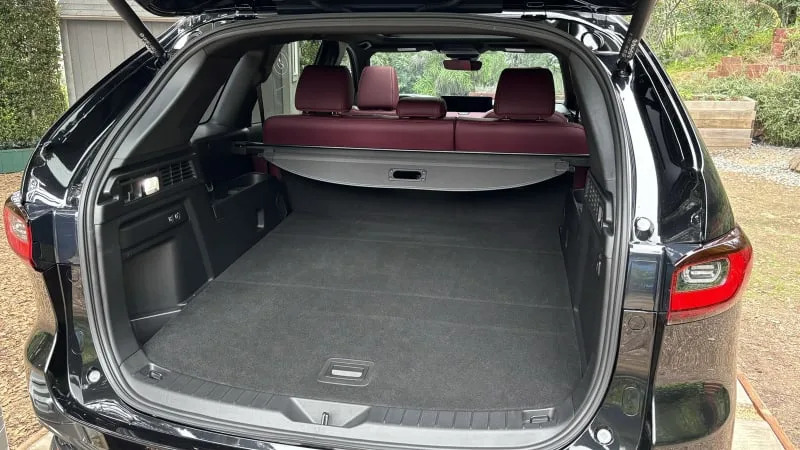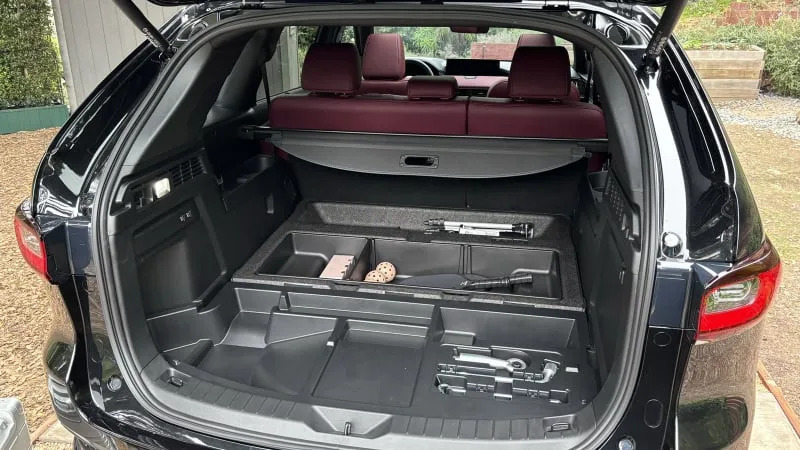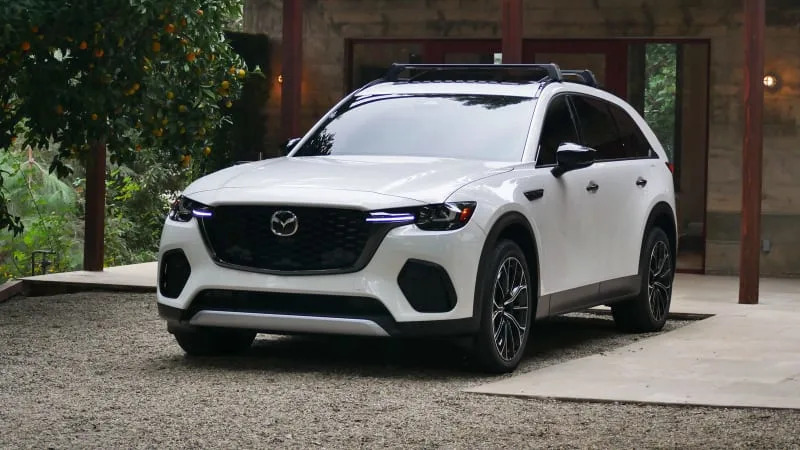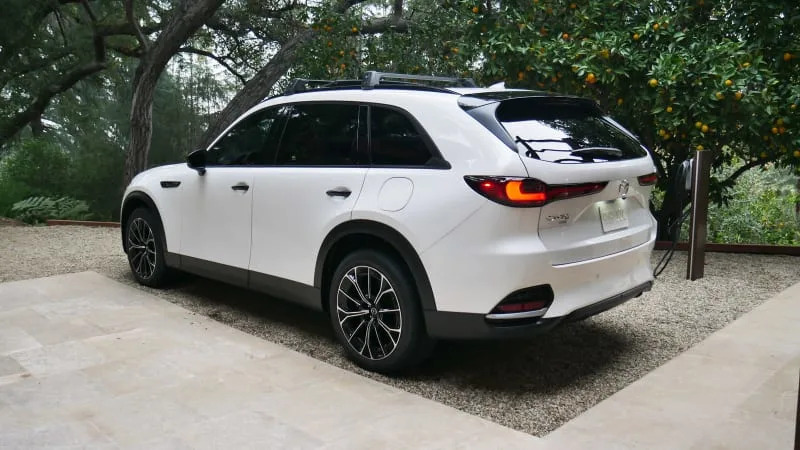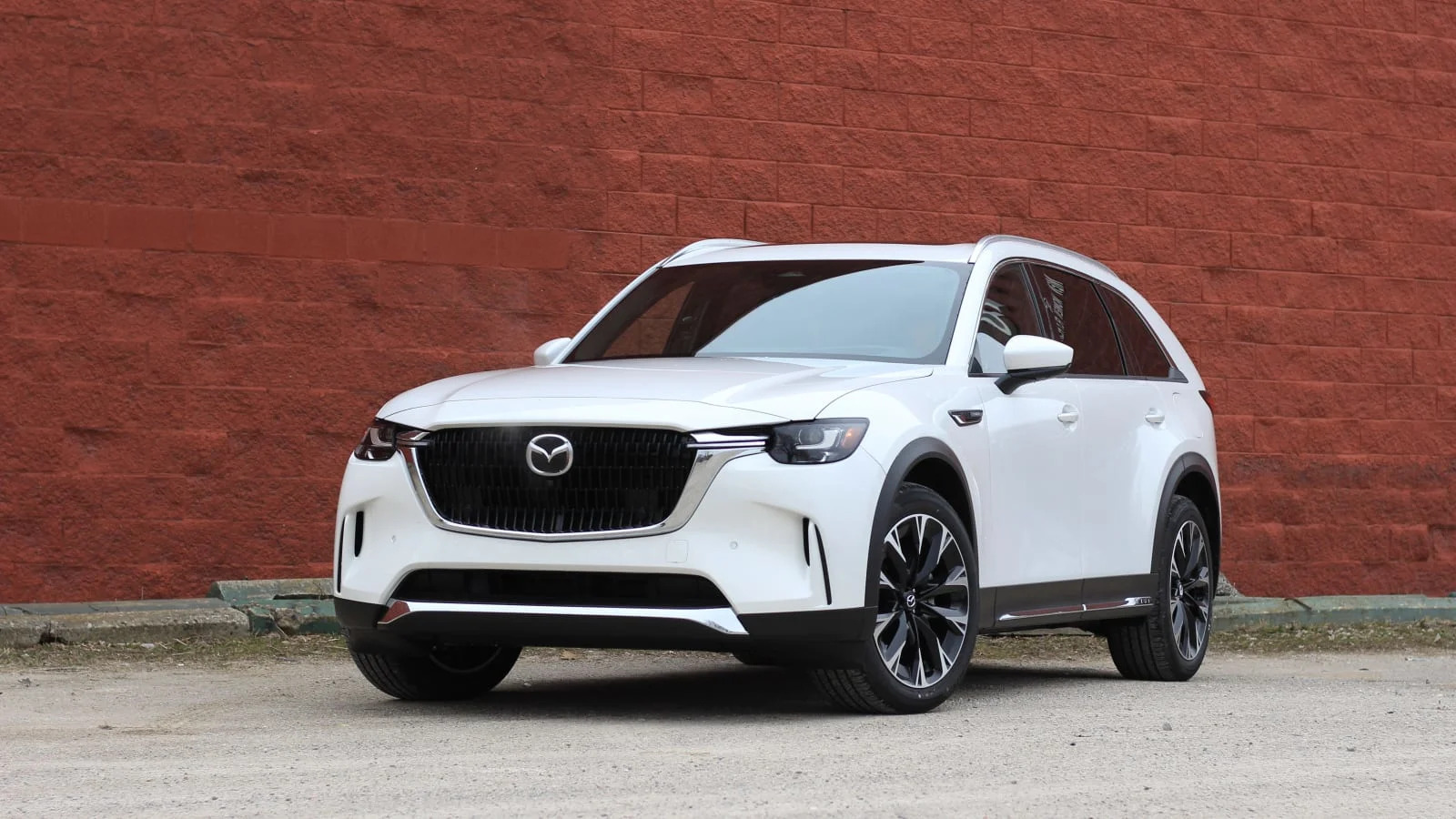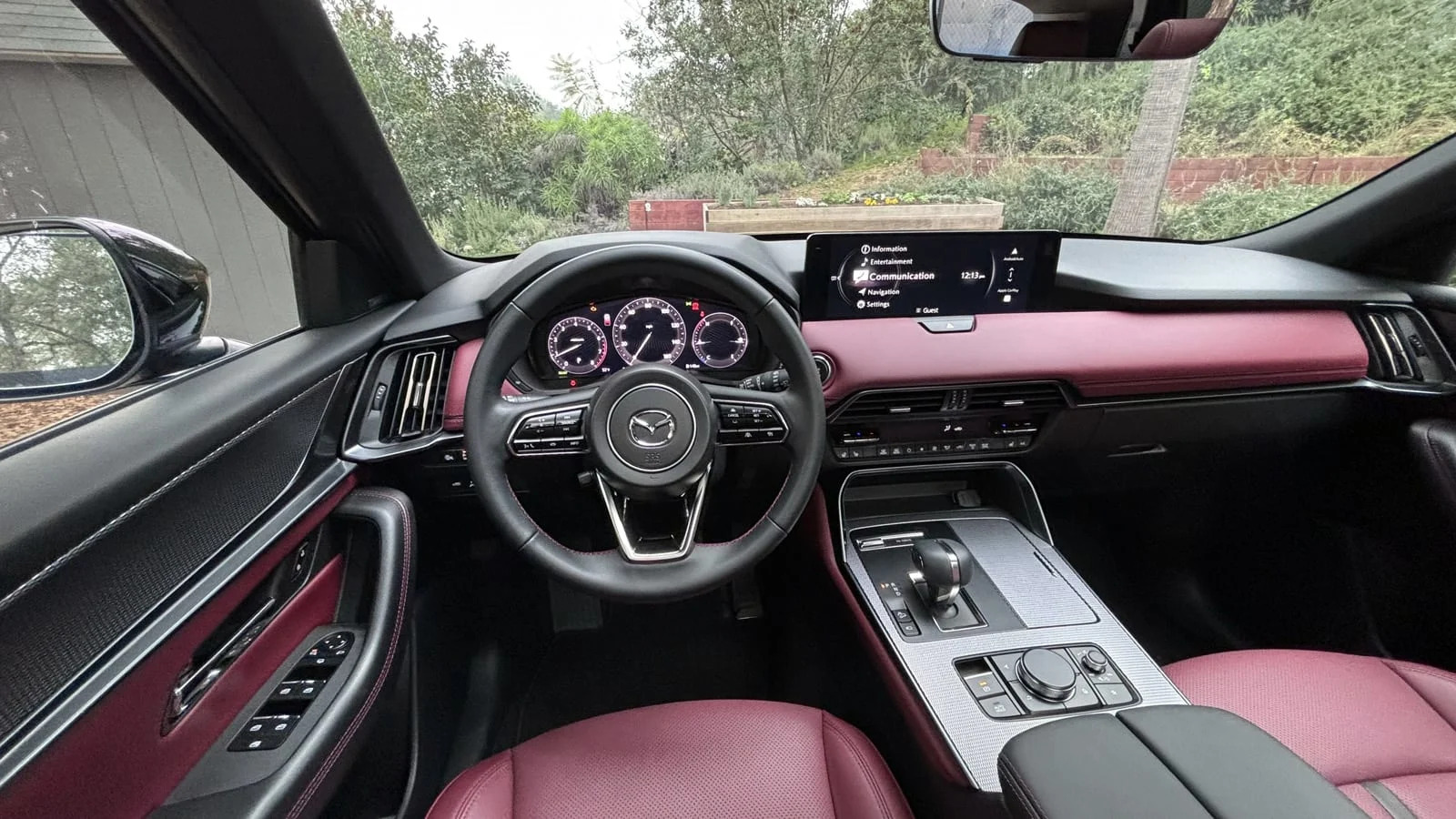Pros: Luxurious interior; exceptional handling and steering; strong power; above-average fuel economy; more spacious than two-row rivals; comparatively low-priced PHEV
Cons: Infotainment won’t be for everyone; otherwise identical three-row CX-90 is more versatile; unrefined PHEV with so-so electric range
The 2025 Mazda CX-70 is effectively a two-row version of Mazda’s three-row CX-90. There are a few token styling tweaks up front, some unique color offerings, a power-folding second seat and some tech upgrades (that’ll certainly be added to the CX-90 eventually), but those are elements that could just as easily be included with an optional package. So why introduce a whole different model?
The answer is marketing and internet research. Quite simply, people searching for a two-row, midsize SUV – including luxury models Mazda wants to compete with – will not stumble upon the CX-90. It’s slotted into a silo with three-row SUVs, yet Mazda believes it has the feature content, interior panache, driving dynamics and looks to compare favorably to two-row SUVs like the Lexus RX, Jeep Grand Cherokee and BMW X5. There’s merit to that belief, but to get the CX-90 in front of those potential customers, it’s a lot simpler if it’s called a CX-70. It’s all about that initial discovery – if one of those potential customers ultimately gets a CX-90 anyway, they still bought a Mazda and the plan worked. It’s made even simpler by the fact the two are identically priced.
So that’s the explanation, but regardless of what it’s called, is it actually worth buying? Well, the CX-70 does deserve the comparisons to premium and luxury vehicles, especially if you’re looking toward that end of the market for a more engaging driving experience. For a big, midsize SUV, it is great to drive, especially if you’ve just come from a sport sedan. That applies to either of its two turbocharged inline-six engines or the CX-70 PHEV that’s considerably cheaper than rival plug-in hybrids.
Interior quality is exceptional for a mainstream brand, and although the switchgear and supporting plastics aren’t quite up to Lexus or BMW levels, the upper trim levels boast beautiful finishings that absolutely stack up to the luxury crowd. At a lower price, we should add. Now, Mazda’s infotainment system won’t be for everyone, although if you are used to Lexus or BMW, it shouldn’t be that foreign of a concept to mostly control the screen using a controller on the center console. Unlike the CX-90 (for now at least), every CX-70 comes with touchscreen capability for Apple CarPlay and Android Auto only.
Now, because the CX-70 is a three-row SUV with the third row deleted, it has a massive cargo area for a two-row model. It may fall just short of the boxier Honda Passport (itself just a two-row, last-generation Honda Pilot), but it betters the Grand Cherokee and blows away the Lexus RX. There’s also some underfloor storage space in place of a third row, but it’s difficult to access and, honestly, we think it’s more likely that someone would use the CX-90’s third-row seat.
And as such, we’d recommend the CX-90 instead of the CX-70 just because of that added versatility and because the price is identical. Should you dig one of the CX-70’s special colors, though, and want touchscreen capability on lower trims, it seems like the lower number is what you’ll want.
Interior & Technology | Passenger & Cargo Space | Performance & Fuel Economy
What it’s like to drive | Pricing & Trim Levels | Crash Ratings & Safety Features
What’s new for 2025?
The CX-70 is a new model for 2025, but as described above, it’s basically a two-row variant of the three-row CX-90. So the name is new, but car, not so much. It is updated compared to the CX-90, though, most notably with touchscreen capability standard on every trim level.
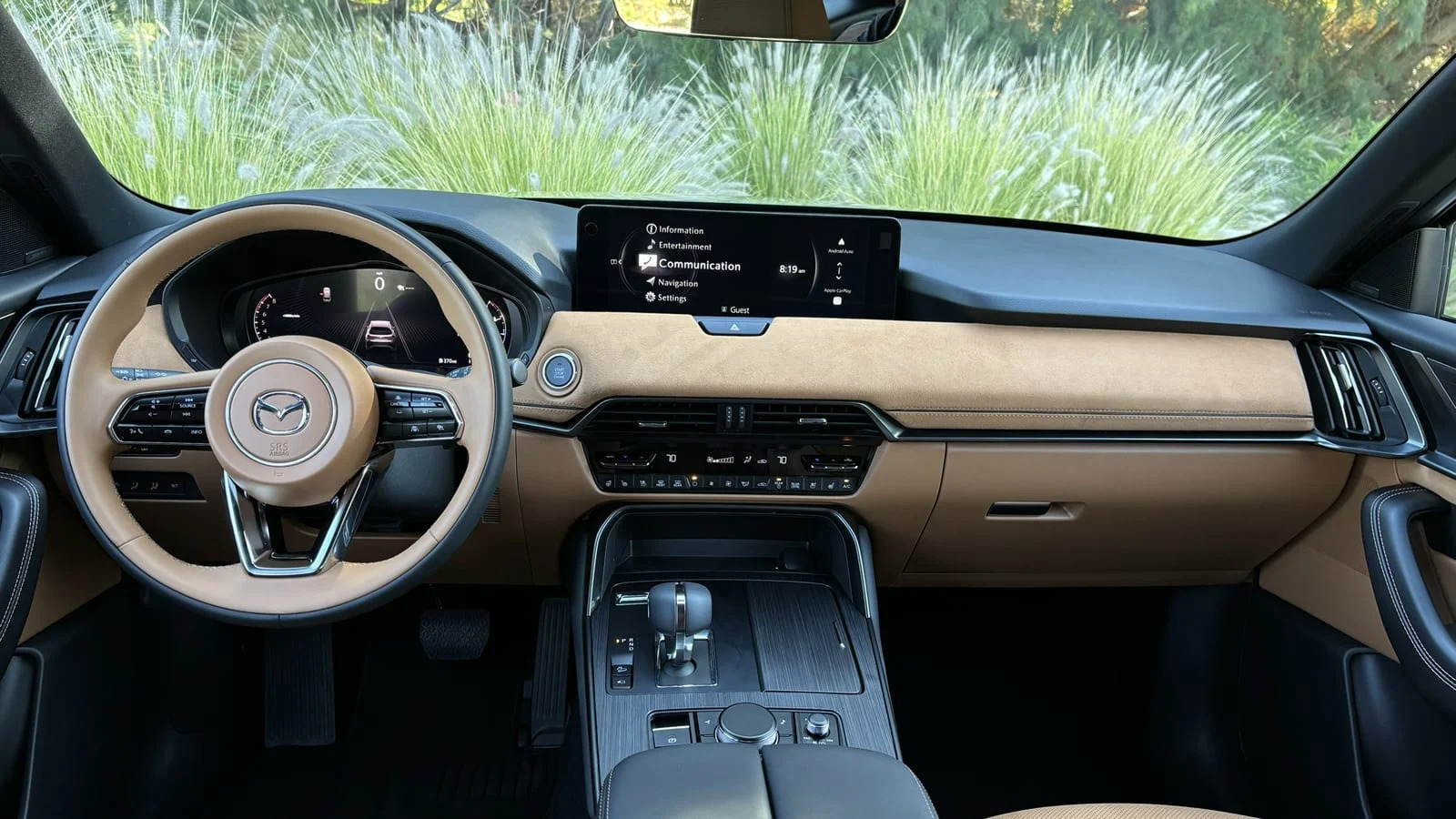
What are the CX-70 interior and in-car technology like?
The CX-70 interior is virtually identical to the CX-90s, with a few exceptions we’ll get to, mostly in the next section. You can get it in a red two-tone color scheme not available in the CX-90, but other options are shared such as the beautiful tan shown above (the seats are covered in Nappa leather; the dash trim is a suede-like cloth). Again, the commonality doesn’t really matter. What does is that this cabin looks great – its clean design puts visual emphasis on its elevated materials while not eliminating physical controls. Specifically, it still has climate control buttons, which seems like a win these days.
All but the base Preferred trim level have a 12.3-inch digital instrument display with two main views: a traditional three-gauge layout and, when adaptive cruise control is at the ready, a more modern design that pushes the speedo and tach to the screen edges while an active driver assistance graphic illustrates what the car is doing and detecting around it.
Every trim level gets the same 12.3-inch central display. It operates as a touchscreen only when operating Apple CarPlay and Android Auto, which can also be operated by the center console control knob and supporting menu buttons. Doing so is a bit confusing, and it takes some playing around with to figure it out, but we’ve found in our CX-90 that having the redundant rotary knob/button control of CarPlay and Android Auto can actually be a benefit. Now, if you want to do anything else with the infotainment system such as select a radio station, program the native navigation system or adjust some other vehicle setting, you must use the center console controls. Generally, we’re OK with this, as it’s perfectly intuitive and doesn’t divert your eyes away from the road as much. To that end, the screen is much higher on the dash and closer to the driver’s field of vision. It’s also further away from your hands, which is one detriment to using the CarPlay/Android touch capability. In total, it won’t be for everyone and is certainly unusual, but we think it’s fine.
How big is the CX-70?
As previously stated, the CX-70 has two seating rows in a body originally intended to have three. Instead of that third row, there is a “sub trunk” as Mazda calls it, with some bins designed to keep smaller items in place. We’re not sure how helpful this space is, however, as it’s quite a reach to access them. Even if a two-row SUV is all you want, we think you’d be more likely to occasionally use a third row instead of this sub trunk. Cargo capacity stands at 39.6 cubic feet with the back seat raised, and when lowered using the CX-70’s remote power-folding capability (not available on CX-90), it goes up to 75.3. This makes the CX-70 one of the most voluminous two-row crossovers.
Space for passengers is similarly generous. Its backseat legroom matches the more family-oriented Honda Passport, betters the similarly luxurious Jeep Grand Cherokee by an inch, and betters the far more expensive Lexus RX by 2 inches. Headroom is greater than the RX, too, and in general, the CX-70’s back seat just feels more airy and open.
What are the CX-70 fuel economy and performance specs?
The CX-70 offers three powertrain options.
Those carrying the name 3.3 Turbo have a 3.3-liter turbocharged inline-six that produces 280 horsepower and 332 pound-feet of torque. An eight-speed automatic transmission and all-wheel drive are standard. Fuel economy is an EPA-estimated 24 miles per gallon city, 28 mpg highway and 25 mpg combined. This is above average for a midsize SUV of its size, regardless of seating rows.
The CX-70 3.3 Turbo S has a higher-output version of the same engine, resulting in 340 hp and 369 lb-ft of torque. This is a considerable amount of power when compared to the engines found in competitors, both from mainstream brands and luxury ones. Fuel economy is also basically the same as the lower-output version at 23/28/25 mpg.
Then there is the CX-70 PHEV, which, as the name indicates, is a plug-in hybrid. It has a 2.5-liter inline-four that works with an electric motor sandwiched between the engine and eight-speed transmission to produce a total system output of 323 hp and 369 lb-ft of torque. As it carries a 17.8-kilowatt battery pack, the PHEV weighs 335 pounds more than the Turbo S, so it will be slower despite its similar powertrain output. The CX-70 PHEV can travel an estimated 26 miles on electricity alone, and the EPA has rated it at 56 miles-per-gallon equivalent. This is virtually identical to the Jeep Grand Cherokee 4xe, but worse than other PHEV SUVs.
What’s the CX-70 like to drive?
As with other Mazdas, the CX-70 will be a great choice if you’re coming from a sport sedan or just prefer a more engaging driving experience. Its taut body control, feelsome steering and responsive throttle and transmission (especially in Sport mode) amount to a vehicle that’ll keep you involved and even amused regardless of where you’re going. The best dynamic comparison is Porsche, it’s just that good.
We have yet to sample the base 3.3 Turbo, but the Turbo S (as if the Porsche analogy wasn’t strong enough) is far gutsier than anything you’ll find in the various luxury and mainstream alternatives we’ve been mentioning. Its power is certainly in keeping with something that has luxury aspirations, but the sound is not. Inline-sixes usually sound fantastic, but this one is on the raspy side, and given the performance bent of the Turbo S, we think Mazda could’ve spruced the experience up (and drowned out the raspy engine) with a zestier exhaust note.
As for the CX-70 PHEV, it’s not the most refined plug-in hybrid powertrain. It has a tendency to make some awry groaning noises under low-speed load, and you’ll feel every shift from the transmission, some more than others. This also applies when run in Electric mode, as each shift lightly rocks you in the cabin, and its lack of power means the gas motor kicks on more frequently than in other PHEVs. Nevertheless, if you’re mostly concerned with burning as little gas as possible, the loss of refinement may be worth it. And in that case, don’t worry, you’ll get the same zesty handling and steering as the Turbo S models with the PHEV.
What other Mazda CX-70 reviews can I read?
Mazda CX-90 Long-Term Test
Autoblog is testing a 2024 CX-90 PHEV for a year and as many miles as we can muster. You can find all our updates in the link above.
What is the 2025 CX-70 price?
The CX-70 is priced identically to the CX-90, or more accurately, its trim levels are priced identically to those it shares with the CX-90. The 90 starts lower overall because the 70 is not offered with the base Turbo Select trim level. The CX-70 does not have a third row, but it does have a power-folding second row, under-floor storage, unique color choices (Melting Copper and Zircon Sand, which is pictured above) and a few features we anticipate will be added to the 2025 CX-90 (online navigation connectivity, an unresponsive driver support system, and touchscreen capability for every trim level).
The CX-70 trim level structure follows the typical, ladder-type of more equipment and nicer finishings being added with each trim level. The names Turbo, Turbo S and PHEV identify the powertrain in question. There are no performance, off-road or other special versions.
All prices below include the $1,455 destination charge. Take note that the PHEV costs less than $2,000 more than the comparable Turbo S trims.
Turbo Preferred: $41,900
Turbo Premium: $47,355
Turbo Premium Plus: $50,355
Turbo S Premium: $53,905
Turbo S Premium Plus: $57,405
PHEV Premium: $55,855
PHEV Premium Plus: $58,905
What are the Mazda CX-70 safety ratings and driver assistance features?
The CX-70 has not been crash tested by the Insurance Institute of Highway Safety, but if it’s any different than the CX-90, we’d be stunned. The CX-90 received the top honor of Top Safety Pick+ for 2024 for its best-possible ratings in all crashworthiness and crash prevention tests. Its headlights got a sufficiently high Good or Acceptable rating depending on trim level. The NHTSA has also tested the CX-90, giving it five out of five stars overall. The Turbo curiously got four stars for frontal crash protection compared to the PHEV’s five-star rating, but both got the same five-star side rating.
Every 2025 CX-70 comes standard with forward collision warning, automatic emergency braking, blind-spot and rear cross-traffic warning, lane-departure warning, lane-keeping assist, a driver inattention warning system, front and rear parking sensors, and adaptive cruise control with stop-and-go capability. All but the base Preferred trim level get emergency steering assist added to the blind-spot and lane-departure systems (as well as a head-on traffic avoidance assist function), traffic sign recognition, and lane-centering steering assist for the adaptive cruise control system. Premium Plus trim levels get enhanced automatic emergency braking that works in reverse and in response to the cross-traffic warning systems. That includes an added forward cross-traffic system. A 360-degree parking camera is also added.




